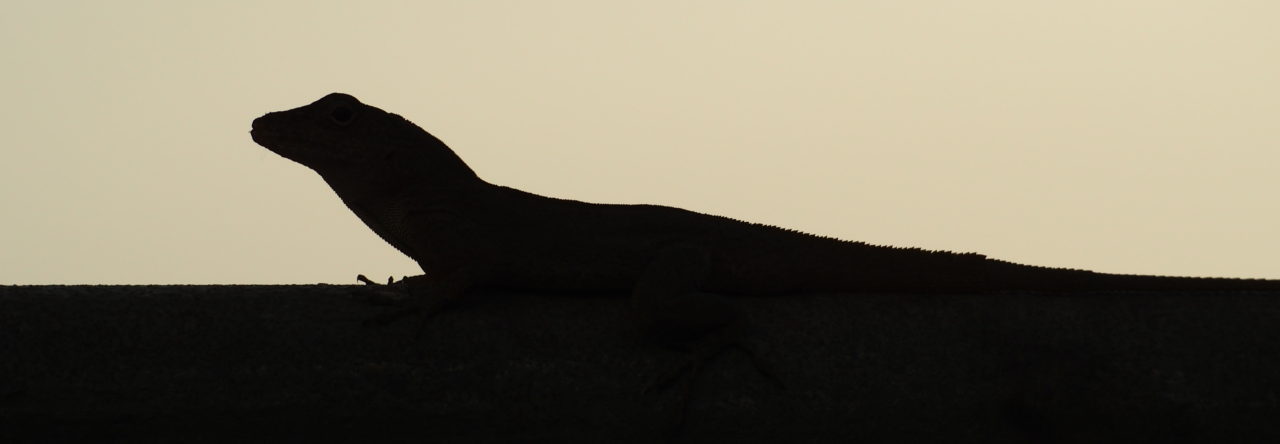
Anolis blanquillanus. Photo by Martin Dávila.
Anolis blanquillanus is a rare lizard that occurs on the flattened Blanquilla Island and on Los Hermanos archipelago (the Brother’s Archipelago), which comprises a series of seven islets or Morros that emerge abruptly from the sea. These islands are ubiquitous in the Venezuelan Caribbean Sea and have never been connected to the mainland. A recent visit to Los Hermanos archipelago from 16-19th of August 2013, sponsored by the Laboratorio de Protección y Manejo de Cuencas at the Instituto Venezolano de Investigaciones Científicas (IVIC), allowed us to make some observations of this interesting lizard. Specifically, we had the opportunity to visit Morro Fondeadero (36 ha, 0.5 Km2, 120 m of elevation), one of the seven Morros that make up Los Hermanos archipelago. This group of islands forms an arc to the southeast of Isla La Blanquilla and is located approximately 80 km NW of Isla de Margarita, 10 km SE of La Blanquilla, and 160 km N of the Venezuelan mainland (Puerto La Cruz).

Morro Pando seen from Morro Fondeadero. In the background is Morro grueso, behind this, El Rajao, one of the two Morochos (the Twins). Photo by Martin Davila.
One of the goals of this trip was to study the terrestrial herpetofauna, which is mainly composed of lizards, although marine turtles also inhabit the surrounding areas (but there are not nesting beaches). My personal goal was to collect an undescribed species of Gymnophthalmid lizard, observed more than 70 years ago in this archipelago by the Dutch naturalist P. Wagennar Hummelinck, but never collected until our recent survey work. Los Hermanos and La Blanquilla were surveyed by Hummelinck during the late 1930s, which resulted in the description of Anolis blanquillanus and Phyllodactylus rutteni. More recently, these islands are rarely visited, although on occasion fishermen climb to Morro Fondeadero mainly to make a prayer to the Virgen del Valle (the Valley Virgin) in order that she protect them during the time they are working on the sea.
During the five days we spent at Morro Fondeadero, we had the opportunity to take some data on Anolis blanquillanus, the most commonly observed reptile on the island. The vegetation in this Morro is composed of cactuses, some bushes and isolated trees (Ficus sp.). Temperatures can reach over 40ºC and the relief possesses much inclination. For this reason, we decided to sleep on a little less inclined rocky surface that would be a safer place to sleep, although not comfortable.
During the first day, after we found the place for our provisional camp, we opened a small trail in search for the summit to verify vegetation data we had obtained using satellite images. On this trail we saw the first individual of A. blanquillanus; after that first encounter, many additional juveniles and adults appeared before our eyes, including males fighting! Some individuals were very curious, approaching us very close, head bobbing and displaying their dewlaps.

Female A. blanquillanus. Photo by Martin Dávila.
To my surprise, all individuals observed were in good condition in spite of the very dry habitat resulting from the particularly long and dry season. I observed some individuals jumping from their perch trying to catch insects. Also I had the opportunity to see a big male swallowing a small fruit of Ficus sp. One individual that we collected defecated digested fruit of Ficus sp. while it was in the bag. Also, I was surprised with how two males were fighting only approximately two meters away from us without caring much for our presence. Anolis blanquillanus, along with Gonatodes naufragus, Phyllodatylus rutteni and Iguana iguana, are the only species (all natives) that have colonized Morro Fondeadero. Interestingly, species such as Cnemidophorus leucopsammus, the most common lizard in La Blanquilla, is absent, although Hummelinck reported the species there. Nine of us worked intensively during the day for four days, and no Cnemidophorus were observed, nor were P. rutteni (also observed by Hummelinck in 1940). Our findings suggest that it is unlikely C. leucopsammus ever existed there; however, it might exist in low densities, or it might have been extirpated by exotic species, such as domestic rats (Rattus rattus) that are very common on the island.
Read More
















